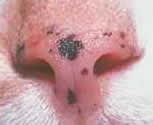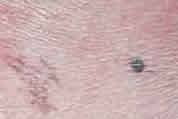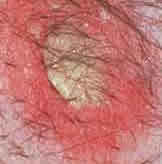Cat Skin Rash
Cat skin rash can have a number of causes. They also can be of a primary cause, meaning something specific to the area of skin that doesn't look right or secondary, meaning that it is a result of something else that is wrong with your cat.
It can be difficult to accurately diagnosis a cat skin condition. Your veterinarian will go through a series of steps to make an accurate diagnosis at detailed below. If you hear the name "dermatitis", know that it is a generic word that is used to describe any skin condition.
See our guide to cat skin problems for pictures of common skin rashes, lumps and pumps so you can match your cat's condition.
Types of Cat Skin Rash
A rash is referred to as a skin lesion. It tends to be comprised of three types of skin problems:
Cat Skin Macules -these look like circles are flat, not raised and red in color or have a color that is different than the rest of the skin. They are no larger than 1/2 inch (1 centimeter).

Picture of Cat Skin Macule on Face
Causes:
- Infection (staphylococcal pyoderma)
- Flea Allergy
- Skin Allergy to Toxins (chemicals, things in your cats environment, called vasculitis)
- Medications your cat is taking (erythema multiforme)
- Blood coagulation problem (coagulopathies).
- Tumor on the testicles (in males) - rash near anus, scrotum and penis
- Vitiligo - white patches of skin, the condition is often inherited
Unfortunately, it is possible that the cause of the rash is never discovered ( idiopathic depigmentation).
Cat Skin Papules - these look like small red pimples that are less than 1/2 inch in size (less than 1 centimeter).
Causes of cat skin papules:
- Infection (staphylococcal pyoderma)
- Flea Allergy (fleabite hypersensitivity)
- Scabies (mange)
- Skin Allergy (atopic dermatitis)
- Bites from flies (fly bite hypersensitivity)
- Reaction to something in your cats Environment (contact dermatitis)

Picture of Cat skin Papule
Erythema - in this condition the rash is not solidly red or continuous in one area, but interspersed with areas of normal skin. This condition is usually caused by some other problem that your cat that is affecting the skin. It is a warning that you should bring your cat to the veterinarian for a thorough exam.
Postules - these are also look like circles with the center raised with pus.
Causes:
- Skin Infection (staphylococcal pyoderma)
- Mange (sacbies, demodicosis)
- Autoimmune skin condition (called pemphigus where your cat's immune system attacks the skin)

Picture of Cat Skin Pustule
Scabs - when pus comes out of a papule or pustule and dries on the surface. This condition is associated with milliary dermatitis which is a pattern of pimples that look like a collection of seeds. If the condition is at the tail base then the problem is probably caused by fleas. It it is at the head then it is a good chance that mites are causing the problem.
Another cause is infection. Something called a staphylococcal ring could appear with hair loss in a circular area (alopecia).
Diagnosis of Cat Skin Rash
The first step of diagnosis is to understand if your cat breed is prone to the skin condition being observed.
Cat Skin Problems and Cat Breeds |
|
|---|---|
|
Breed |
Skin Problem |
|
Abyssinian Cat |
Ear inflammation, hair loss or skin injury due to anxiety, excessive grooming |
| Persian Cat |
Parasite infestation (dandruff), fungal infection, dermatitis (redness) in the folds of the skin (called intertrigo), oily, crusty skin (seborrhea). Facial dermatitis is not always of know cause. |
|
Siamese Cat |
Reaction to food, less than normal amount of hair (hypotrichosis), white hair in a specific area, smooth white patches of skin (Vitiligo). |
Skin Rashes - Problems on the Neck and Face
Assuming a condition is not associated with your specific breed, the location of the skin problem may be a clue as to the cause.
Common causes of problems on your cat's face and neck include:
- Allergy (called atopic dermatitis) - sometimes accompanied by itch (pruritis)
- Allergic Reaction to Insects Known as Parasites (called arthropod bite hypersensitivity)
- Bad Reaction to Food - Sometimes very itchy (pruritis)
- Parasite Infestations (mange, notoedric mange, otodectic mange)
- Skin Fungus Problem (dermatophytosis)
Other less common causes of skin rash and problems on the face and neck include:
- Parasites (demodicosis, cheyletiellosis, trombiculosis)
- Reactions to other insects such as mosquito bites
- Conditions due to the immune system attacking the skin (called immune-mediated) including reactions to a new drug
- Virus - Feline herpesvirus-1, Papillomavirus-induced plaques, FeLV-associated dermatosis)
- Abnormal Cell Growth (neoplasm) - caused by over exposure to the sun (actinic keratosis)
It is also possible that your veterinarian will not be able to diagnose the cause of the condition (called idiopathic). This includes some types of neck conditions (ulcerative dermatitis).
Diagnosing and Treating Cat Skin Rash
Since diagnosis is difficult, your veterinarian will go through several steps which rule out those things that are easier to diagnose and then move on to causes like allergy which require modifications to your cat's diet.
The first step is to rule out bacteria, fungus or parasites as a cause of the condition. Your veterinarian will put some skin, ear and hair samples under a microscope for examination. They may also recommend a topical treatment for fungus or parasite problems to see if that helps the problem.
Food Allergy and Cat Skin Rash
If allergy is suspected then a determination will be made if it was due to diet or food.If diet, then your cat will be place on what is called an elimination diet. Here your cat will be placed on a diet with only one or two ingredients. If the rash goes away then food allergy or food intolerance was the cause. Other ingredients will be introduced until it is determined which food was causing the reaction. The goal is to have your cat back on the original diet less the offending food in 2 to 3 weeks. If diet is not not the cause then it is assumed that the problem might be cause by fleas.
Flea Allergy and Cat Skin Rash
If skin allergy due to a reaction to flea bites, then a spot on that controls fleas will be recommended. You will also need to eliminate fleas from your cats environment with a product like Benzarid that kills fleas that remain inside your home.
Feline Skin Allergy (feline atopy)
Your veterinarian may take a skin sample to study in the lab to help with the diagnosis (biopsy). Other areas to explore include mosquito bites or a toxic chemical in the house such as insect repellents (very toxic).
Other Causes of Cat Skin Rash
A cat skin rash can be a symptom of other health problems, such as thyroid problems. Your vet will evaluate your cat for these problems when diagnosing the cause of her skin rash. See our guide to cat skin problems for other causes of cat skin rash.
Sources:
Carter, G.R., Wise, D.J., and Flores, E.F. (Eds)
A Concise Review of Veterinary Virology
Understanding the Language of the Skin
Peter Hill, BVSc, PhD, DVD, DipACVD, MRCVS
The Royal (Dick) School of Veterinary Studies
The University of Edinburgh, Scotland
Feline Facial (and Neck) Dermatitis: A Problem-oriented Approach
A. Fondati
Clinica Veterinaria Prati, Italy.
From Cat Skin Rash to More on Cat Skin Problems
To Cat Health Guide Home